 |
||
|
||
| ||
Video
 At the Game Developers Conference DirectX Day (MSDXDay) in the end of March Microsoft presented the next generation 3D technology - DirectX 9, to be officially announced in summer 2002. The full DirectX 9 specifications will be released in summer as well. And now we have the following general information about the product:
The actual release of DirectX 9 is planned to 2003, however, I assume manufacturers will begin talking about its support in some months already. NVIDIA, having released the new generation of its GPUs in February, continues to consolidate its market position. In contrast to ATi, making partnerships by offering technologies and considerable discounts to partners, NVIDIA bases its position by its leading brand, being the de facto industry standard. Due to this, its partners almost do not have to spend for additional advertising to promote their products. At CeBIT 2002, the largest industry event of March, NVIDIA partners presented a wide range of solutions based on new GeForce4 MX and GeForce4 Ti GPUs. It's now clear that these chips were not only presented, but also actually delivered to partners, as many of them have already prepared or started to sell boards on all GPUs requested. However, March showed that the most junior GeForce4 Ti 4200 GPUs of NV25 line were "held back" for a while to get rid of previous generation stocks - GeForce3 Ti 500 and GeForce3 Ti 200. In order to do this NVIDIA reduced prices for GeForce3 Ti500 and GeForce3 Ti200 twice in the middle of February. Still, the first GeForce4 Ti 4200 cards have already been seen for sale in Japan, so we might see them at our places rather soon. 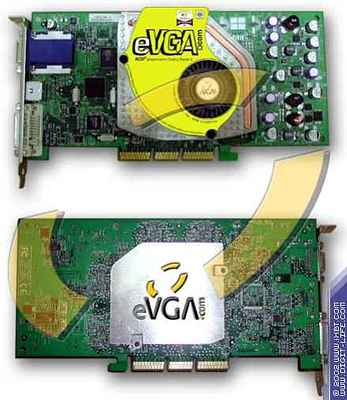 The GF4 Ti4600 card from eVGA.com featuring the ACS 2 (Asymmetric Cooling System 2) was one of the really outstanding solutions. ACS 2, being only 11.7 mm thick, has a copper heatsink and three heat-removing pipes (Heat Pipe Technology): one from the solder side, two from the mount side. An interesting cooler creates two airflows simultaneously: from above and below. eVGA.com is expected to announce ACS 2 as a separate solution soon. Gainward traditionally distinguished itself with a curiosity, having announced the release of Gainward Ultra/750XP card, based on NVIDIA GeForce4 Ti4600 GPU. Gainward Ultra/750XP will be exclusively equipped with two digital DVI-Outs, which you can also use in analog and TV-Out modes via adapters. Besides, Gainward Ultra/750XP will feature a child 3-port FireWire board and a couple of 3D glasses. 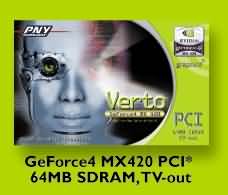 There were also PCI cards on GeForce4. PNY Technologies announced the release of a PCI version on the most junior GeForce4 MX 420 chip of the line with 250 MHz clock rate. The product will feature 64 MBytes 166 MHz SDRAM. PNY is also going to release a DDR version of GeForce4 MX PCI in the future.  The NVIDIA Quadro4 900XGL/750XGL/550XGL professional chip line announced in February became the base for GLoria4 workstation card series from ELSA. However, we still do not know about actual release of cards from this company. Nevertheless, ELSA still pretends everything is fine. 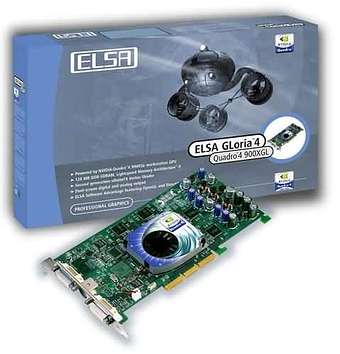 It presented the following cards: GLoria4 900XGL (128 MBytes DDR, 300/660 MHz, dual VGA + VGA, VGA + DVI, and DVI + DVI outs), GLoria4 750XGL (128 MBytes DDR, 275/550 MHz, dual VGA + VGA and VGA + DVI outs), and SYNERGY4 550XGL (64 MBytes DDR, 270/400 MHz, analog out). As ATi hasn't prepared any new chips for the Hannover exhibition, its partners had to show existing solutions at CeBIT 2002. We haven't still seen the XT (Ultra) version of Radeon 8500 with 300/600 MHz chip/memory clock rate, as well as RV250 chip. All Radeon 300 MHz 8500 cards demonstrated were the overclocked versions of usual Radeon 8500. 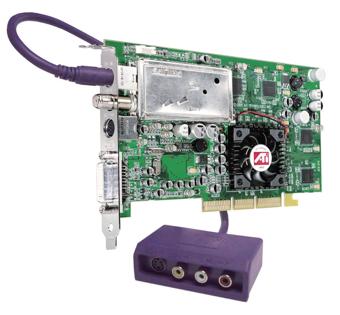 128 MBytes All-In-Wonder Radeon 8500 from ATi became one of the really interesting novelties of March. Compaq chose it to equip desktop Presario 6000 and Presario 8000 series. Unlike usual 64 MBytes AIW Radeon 8500, working at 230/380 MHz, 128 MBytes All-In-Wonder Radeon 8500 work at 275/550 MHz. Other features are alike: DVI, VGA, and TV outs, 125-channel stereo TV tuner, TV-On-Demand (pause, recording, playback), Hydravision Dual Display, Video Immersion II, radio remote control, etc. Hydravision Dual Display, Video Immersion II. PowerVR used CeBIT 2002 to announce the new KYRO II SE GPU, working at 200 MHz and supporting price-balanced EnT&L technology for economical solutions along with Smarter Rendering, Textur8 (8-level single pass texturing), TrueRender, Bump Map Complete, Internal True Colour technologies. PowerVR KYRO II SE also includes 128-bit 2D engine, video playback and DVD decoding hardware support, AGP 4x, 128-bit SGRAM/SDRAM support (64 MBytes).  We can't say that KYRO II SE revolutionized current 3D graphics. KYRO II SE were announced by VideoLogic - Vivid!XS Elite (64 MBytes SDRAM, TV-Out) and 3D Prophet 4800 from Hercules (64 MBytes of 200 MHz memory, TV-Out). Besides, March brought the first information that VIA, or rather its S3 Inc. graphic department negotiates with PowerVR about purchasing licenses for its graphic developments. According to observers, VIA would like to occupy the place on the 3D-graphics market, left after STMicro. S3 might be interested only in a rather inexpensive TBR (Tile Based Rendering) notebook integrated graphics technology from PowerVR, however, to some data VIA would also like to purchase rights for Kyro III graphics core. 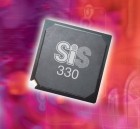 The Hannover exhibition brought us the SiS330 family of GPUs. SiS traditionally promotes its developments for integrated motherboard chipsets. However, by analogy with the previous SiS315 core, we might assume the appearance of separate inexpensive cards on SiS330 GPU, called Xabre or 8X8 (i.e. DirectX 8.1 and AGP 8x support). SiS330 features four pipelines with two texture modules per each, emulates DirectX8 Vertex shaders version 1.1 via CPU and supports DirectX8 Pixel Shaders version 1.3 along with other DirectX 8.1 capabilities: Volume Texture, Bump Mapping, Cubic Mapping, BRDF (bilateral lighting), Shadow Mapping; Hyper FSAA (Full Scene Anti-Aliasing), 128-bit SDR/DDR memory (up to 128 MBytes), AGP 8x and AGP 3.0 specifications. The optional SiS301B video bridge provides dual-display output and a TV-Out. Still, generally, there's no reliable information about DirectX8 support by SiS330, however, things said above show that SiS330 might partially compete with, for example, GeForce4 MX. 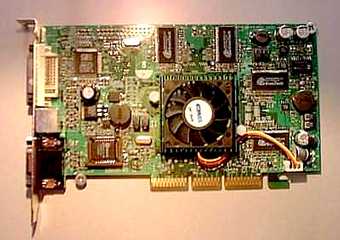 At CeBIT 2002 Elitegroup presented AGP 8x prototypes on SiS336 chips (300 MHz chip / 64 or 128 MBytes of 300 MHz DDR memory, AGP3.0, AGP 8x and DirectX 8.1 support, DVI and TV outs), as well as on SiS332 (250/200 MHz). Mass deliveries of 8X8 Xabre SiS330 family chips - SiS328, SiS332, SiS334, and SiS336 - are planned to the second quarter of 2002. According to preliminary data, the SiS340 DirectX9 chip generation will follow SiS330. Its release is planned to February 2003. March brought one event, significant for Creative Technology: the return to the professional graphics market. It has been done rather simply but tastefully: Creative has just bought 3Dlabs for $104, purchasing its stocks. Having announced this fact, Creative published the special press release, declaring that 3Dlabs will be company's independent department. According to preliminary data, 3Dlabs technological roadmap will remain the same. MonitorsPrices for LCD panels continued to grow in March. Analysts name insufficient production of glass substrates as the main reason, saying that it might push prices higher until 2003. Another serious price growth factor is the environmental protection actions. It has even forced one large substrate manufacturer to close its factory. Taiwanese and South Korean TFT LCD manufacturers are expected to raise prices for monitor and notebook panels. The average rising would make about 10-15% for 15" panels and up to 20% for ha 14.1" ones. However, perhaps in the end of the year, when Korean Samsung and LG.Philips LCD launch new 5th generation panel fabs, substrate deficit would reduce, pulling prices along. Each company is going to at least double yielding before the year-end. LG.Philips, currently controlling 17.4% of the LCD market, is going to launch production of panels on new 1x1.2 m substrates in the 2nd quarter, enabling itself to outrun Samsung, controlling 21.4% of the market. However, the balance would shift back in the 4th quarter when Samsung launched its own production of 5th generation panels on 1.1 x 2.5 m substrates. And now Samsung announced the production of 19" TFT LCD panels, supporting SXGA (1280 x 1024) resolution at 5:4 ratio, 500:1 contrast, and up to 250 candles/sq. inch brightness at 170-degree horizontal and vertical viewing angle. Large LCD displays, presented by several companies at once, were rather interesting. Japanese Sharp began selling its 20.1" TFT LCD LL-T2010W display mainly for CAD, software development, etc. 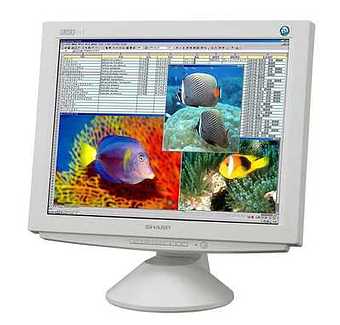 LL-T2010W (about $2500) features UXGA (1600 x 1200) resolution, 0.255 mm pixel size. Maximum brightness is 220 candles/sq. inch, contrast - 350:1, viewing angle - 170 degrees, response time - 25 ms. 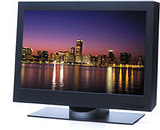 At CeBIT 2002 Iiyama showed the prototype of its 22.2" TFT LCD display, designed according to IBM's IPS technology. It's interesting because of its phenomenal 3840 x 2400 resolution, meeting the QUXGA (Quad-Ultra Extended Graphics Array) standard. The screen has 478 x 299 mm in size, and the display - 547 x 196 x 437 mm. The product supports Quad-DVI from Matrox, maximum brightness is 235 candles/sq. inch, contrast - 400:1. Its release is expected in the 2nd quarter.  Besides, Iiyama demonstrated the new 23.1" AU58xxD series display to be released in the nearest half-year. It has 1600 x 1200 resolution, 250 candles/sq. inch maximum brightness, 400:1 contrast, and 25 ms response time. 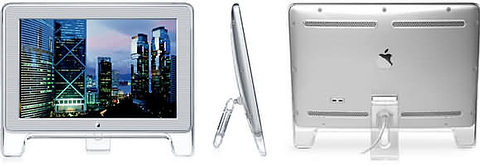 Apple announced the intention to release 23" Cinema HD Display ($3400), supporting 1920 x 1200 (2.3 million pixels) maximum resolution, at Macworld Tokyo. The novelty is less than 5 cm thick and provides real High Definition Television (HDTV) resolution. Horizontal and vertical viewing angle is 160 degrees, maximum brightness - 200 candles/sq. inch, contrast - 350:1. 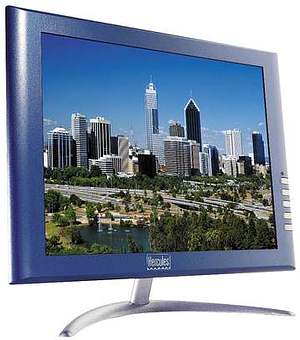 At CeBIT 2002 Hercules presented two new 17" ultra-thin Prophetview 920 and Prophetview 920DVi LCD displays, designed silvery-blue and supporting up to 1280 x 1024 resolution at maximum brightness of 250 candles/sq. inch and 350:1 contrast. Sharp announced the release of two new LCD displays: 16" LL-T1620-H/B SXGA and 15" LL-T1520-H/B XGA. Each model will have two versions: colored black (B) and hoary (H).  LL-T1620-H/B ($600) features 16.3" matrix with 1280 x 1024 resolution, 0.248 mm pixel size, 170-degree viewing angle, 300 candles/sq. inch maximum brightness, 400:1 contrast, and 25 ms response time. It also has analog and digital DVI-I inputs, integrated stereo speakers (2 x 1 W). LL-T1520-H/B ($530) has 15" matrix with 1024 õ 768 resolution, 0.297 mm pixel size, 170-degree viewing angle, 250 candles/sq. inch maximum brightness, 400:1 contrast, and 25 ms response time. It also features integrated stereo speakers, analog and digital DVI-I inputs.  Philips updated its product list with a new interesting 150MT LCD display ($1050) featuring an integrated TV-tuner, enabling you to watch windowed TV broadcasts while working with your PC, stretching it to the full screen if needed. 15" 150MT has 1024 x 768 maximum resolution, 25 ms response time, 310 candles/sq. inch maximal brightness, 500:1 contrast. At CeBIT 2002 LG Electronics demonstrated similar novelties. Its two new 15" displays with integrated TV-tuners support resolutions up to 1024 x 768.  LE-15A15 model has 350 candles/sq. inch maximum brightness, contrast 350:1, features analog VGA jack, SCART, S-Video, and AV jacks. Besides traditional TV-text it also supports picture in picture (PIP). The second model - RE-15LA30 - is more humble: 250 candles/sq. inch maximum brightness, 300:1 contrast. There's no PIP support. 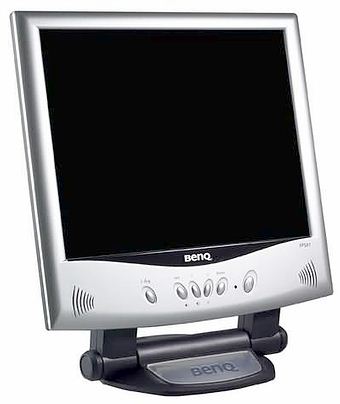 In March BenQ announced 15" FP557 ($380) and FP581s ($420) LCD displays. FP557 is an updated version of FP563, basing on 15" LCD panel from AU Optronics with 1024 x 768 maximum resolution, 0.297 mm pixel size, 250 candles/sq. inch maximum brightness, contrast 350:1 and 30 ms response time. Vertical viewing angle is 100 degrees, horizontal - 120 degrees. FP581s model is similar but with better viewing angle: 140 degrees vertically and 150 degrees horizontally, and integrated speakers (2 õ 1 W). Besides silvery FP581s variant, there will also be white FP581w.  Besides, it seems that a new vendor is going to enter the LCD market. It's MSI that has announced the release of 15" TFT LCD StarView LM510 model. It features 350:1 contrast, 85-degree vertical and 120-degree horizontal viewing angle. NotebooksThe most notebook announcements regarded Pentium 4 - M based models after Intel had announced this CPU in the beginning of March and begun its deliveries. We can also assure that the release of Pentium 4 - M started the serious invasion of DDR memory to the mobile market. New i845MP and i845MZ notebook chipsets support this memory. i845MP, being delivered already, is designed for an external AGP 4x graphics engine; it supports 400 MHz FSB, up to 1 GBytes of DDR266 memory, up to 6 USB ports, 100Base-TX, Ultra ATA/100, ACPI 2.0, etc. i845MZ, to be presented later, is optimized for inexpensive systems and features integrated graphics engine without external AGP support. The main difference between the new mobile CPU and stationary CPUs is the availability of energy-saving capabilities, such as Enhanced Intel SpeedStep - automatic switching between maximum performance and energy-saving modes, depending on CPU load; Deeper Sleep mode, at which CPU works at only 1V and power consumption drops to 0.2W and below (still saving application data); improved Intel Mobile Voltage Positioning (IMVP III) technology for dynamic power supply adjustment, depending on CPU load, enabling to reduce its estimated heat emission intensity.  Toshiba was the first to announce a notebook on 1.7 GHz Pentium 4-M. DynaBook G4/U17PME ($2600) of A4 form-factor on i845MP chipset is equipped with NVIDIA GeForce4 440 Go (32 MBytes DDR SDRAM) graphics engine, 15" UXGA (1600 x 1200) display, 256 MBytes RAM (PC2100 DDR SDRAM, up to 512 MBytes), 40 GBytes Ultra ATA/100 HDD, 8/8/8/24 DVD/CD-RW combo drive. According to the company, the maximum power consumption of this model doesn't exceed 75W.  Sony surprised everybody, having released BioNote PCG-GRX90/P ($2700) model on 1.7 GHz Mobile Pentium 4-M and i845MP chipset with a giant (in terms of notebooks) 16.1" LCD display. It has ATI MOBILITY RADEON 7500 (32 MBytes) graphics engine, 512 MBytes RAM (DDR200, 256 MBytes x 2), 40 GBytes HDD, 8/16/10/24 DVD/CD-RW combo.  Dell released several notebook lines on new Intel Mobile Pentium 4-M at once. Inspiron 8200 ($1700-2900) has 15" SXGA+ or UXGA display, 1.6 GHz or 1.7 GHz Mobile Pentium 4-M (i845MP chipset), 128 MBytes of PC2100 DDR SDRAM (up to 256 MBytes) and NVIDIA GeForce2 Go GPU with 32 MBytes (up to 64 MBytes) of DDR memory. Latitude C840 ($2600 and higher) on 1.6 GHz Mobile Pentium 4-M has 128 MBytes of PC2100 DDR SDRAM, 15" UXGA display, 64 MBytes NVIDIA GeForce4 440 Go. 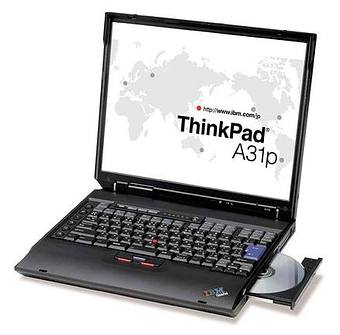 IBM's ThinkPad A31p ($3800 - $4000) series of A4 form-factor with a professional ATI MOBILITY FIRE GL 7800 (64 MBytes) graphics engine bases on 1.7 GHz Mobile Pentium 4-M (i845MP chipset), has 256 MBytes of PC2100 DDR memory (up to 1024 MBytes), 60 GBytes HDD, 8/8/8/24 DVD/CD-RW combo, 15" (1600 x 1200) FlexView display. ThinkPad A31p model differ in pre-installed software. 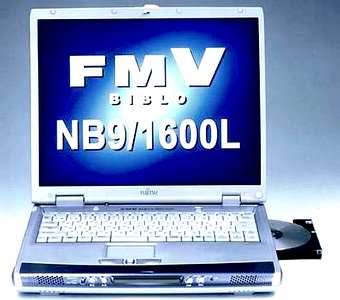 FMV-BIBLO NB9/1600CL ($2300) notebook from Fujitsu on 1.6 GHz Mobile Pentium 4-M features 15" 1024 x 768 display, 256 MBytes RAM (up to 512 MBytes), 40 GBytes HDD, ATI MOBILITY RADEON (8 MBytes) graphics adapter, 8/8/8/24 DVD/CD-RW combo. 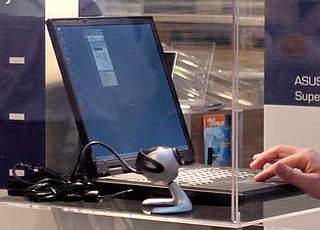 ASUS presented L3 series notebooks on Pentium 4-M, featuring 15" displays, wireless 802.11b interface support. 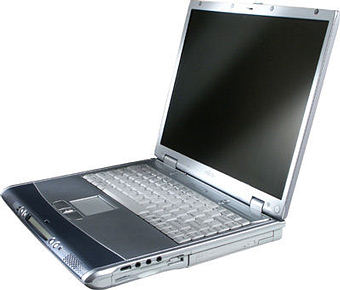 Fujitsu PC announced the release of All-in-One multimedia notebooks on 1.6 GHz Mobile Pentium 4-M (i845MP chipset). LifeBook C ($2000) series is equipped with 15" XGA display, ATI Mobility RADEON 7500 (8 MBytes) graphics adapter, CD-ROM, DVD, or DVD/CD-RW combo, 256 MBytes of DDR266 memory (up to 512 MBytes). However, prices for P4-M notebooks are not long to remain this high. According to preliminary information, in May 1.6 GHz and 1.7 GHz P4-M chips will cheapen down to $210 and $250, respectively. So, CPU price will make about 20% of notebook's price instead of 40%. Prices for previous generation notebooks reduce as well. So, March showed that 1 GHz models were moving to the below $1000 price range. In the 2nd/3rd quarter, most manufacturers are going to present such models mainly on 1 GHz Intel Mobile Celeron CPUs. Another pleasant thing is that this category gets more and more notebooks with DVD-ROM drive and 14.1" display.  VIA, with its new mobile µFCPGA VIA C3 low energy consumption CPUs, working at up to 933 MHz, is making an undoubtful contribution to the following generation of inexpensive notebooks. However, March hasn't brought us any of them. However, March hasn't brought us any of them. In March Sony announced the release of BioNote FX PCG-FX99V/BP ($1700) model of A4 form-factor on 1.2 GHz Mobile Athlon 4 and VIA Apollo KT133A chipset, featuring 15" SXGA+ (1400 x 1050) TFT LCD display, ATI 3D RAGE MOBILITY M1 (8 MBytes) graphics adapter, 256 MBytes RAM, 40 GBytes HDD, DVD/CD-RW combo (8/8/8/24). JVC presented two subminiature MP-XP7210DE and MP-XP3210 notebooks of À5 form-factor. MP-XP7210DE ($2500) has 750 MHz Mobile Pentium III, 256 MB RAM (up to 384 MB).
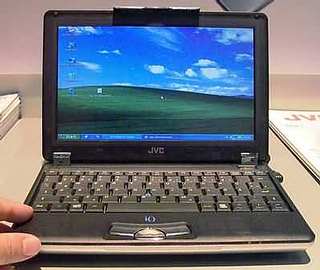 The junior MP-XP3210 ($2000) features 650 MHz Mobile Celeron. Notebook displays are 8.9" in diagonal and support up to 1024 x 600 resolutions. Only pocket PCs may touch in their size and weight, however, which of them are based on Pentium III and have 256 MBytes RAM? At last, really interesting notebooks were presented by Tadpole. Its mobile GENIALStation S-Note 747S ($7425) and 777S ($4710) workstations, are equipped with 400 MHz and 500 MHz Sun UltraSPARC Iie CPUs, respectively, have 14" and 15" XGA LCD displays, 8x CD-RW drives, up to 1 GBytes RAM and 20 GBytes HDDs.  They also feature Solaris 8 OS. Notebooks are produced and sold by Taiwanese Naturetech. Tablet PCsThe large amount of tablet PCs, presented in March, is surely tied to CeBIT 2002. Judging by exhibits, one could have assumed that such devices are rather popular. But most of tablets are just prototypes, and their production quantity, depending on customers, is still questionable. At the Hannover exhibition Microsoft announced that another four leading consumer electronics brands had joined the manufacturers of wireless Mira Web tablet. Now Microsoft's tablets will be produced not only by ViewSonic, NEC, Fujitsu, and Panasonic, but also Royal Philips Electronics, LG Electronics, Tatung, and Trigem.  Most manufacturers will produce Mira under their own brands; however, Taiwanese Tatung and Korean Trigem intend to become OEM vendors for other companies. According to preliminary data, Microsoft intends to present the final version of Mira software closer to the end of summer. The first deliveries are planned to Christmas sales. Mira's price is expected to range in $500-800, depending on LCD display size of a model. Acting in advance, I can say that Intel Xscale was chosen as a platform for Mira tablets.  Taiwanese FIC was awarded CeBIT's "Best of Taiwan's Best" for its Crystal tablet. Crystal's features are generally alike to the previously presented FIC AquaPad: 800 MHz Transmeta Crusoe CPU, 20 GBytes HDD, 256 MBytes RAM. 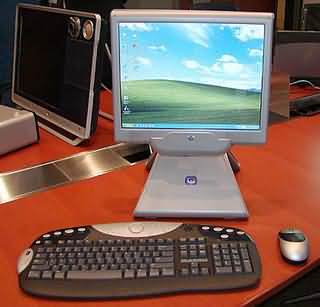 Hewlett Packard presented a concept of a wireless tablet PC - Concept PC 2001. Supplied with a wireless keyboard and a mouse it turns into a desktop PC; rotating the display 180 degrees turns it into a tablet; in the "normal" state it's rather a notebook: 14" display, HDD, optical drive, fingerprint certification, TV-Out, USB, Ethernet, IEEE 1394 ports, integrated speakers and a modem. German ELSA presented a complete and well-considered LogBoard concept-tablet for home use.  LogBoard is based on 300 MHz x86 Geode GX II CPU from National Semiconductor and is equipped with an 8.4" SVGA display. LogBoard doesn't have a keyboard; it features a virtual one instead, realized with the help of screen sensors. 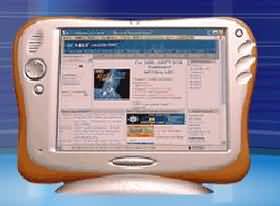 Taiwanese MSI presented another interesting tablet -WebPad MS-2380. The company chose VIA's x86 platform: 533 MHz VIA Eden x86 CPU, VT8606 +VT82C686B chipset. The product has 10.4" 800 x 600 TFT LCD sensor matrix, 2 MBytes ROM, 128 MBytes RAM, 32 MBytes of flash memory. Digital photoThe spring "started" every manufacturer without exception, even those, which remind of themselves seldom. The stream of new cameras was so intense during the last two months, that put me off telling you not only about traditional 1- and 2-megapixel models, but also about a huge amount of 3-megapixel ones. However, such wide assortment of good 3-megapixel products is very pleasant: besides, an obvious price reduction, models of this category are moving from exotics to "consumer" electronics. The new Foveon X3 optical sensor, released by Foveon, and produced according to 0.18-micron CMOS technical process by National Semiconductor became the true exotics and sensation. The sensor is uncommon because its every optical element registers the color of corresponding pixel. Unlike other optical matrixes with staggered photocells, adjusted to one of the three main colors, X3 utilizes elements, recognizing all three colors. In fact, it has got its name after this. 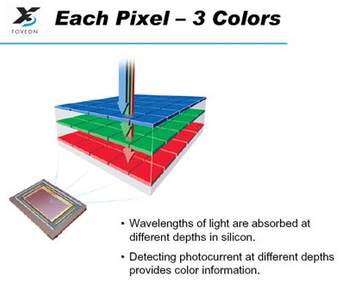 Every optical element of X3 has 3 photodetectors, adjusted for red, green, and blue. They are positioned at various depth of a silicon crystal and use its well-known dispersive properties - wavelength dependent light absorption. Blue, being the most shortwave, is the fastest to be absorbed, so its photodetector is the closest to the surface. Photodetectors for green and red are positioned under it.  X3 has one more feature: Variable Pixel Size (VPS). Smaller size enables to shoot with more resolution and quality, larger pixels enable to shoot in condition of underlighting or record lower-resolution video. This feature of X3 is meant for making hybrid photo cameras. 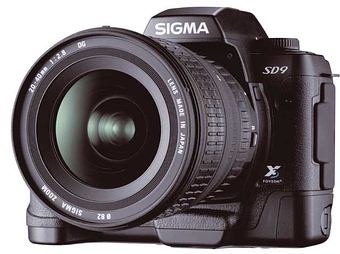 Now X3 sensor is utilized in Sigma DS9 D-SLR (about $3000) digital camera. Besides, Kodak is also known to be interested in X3. The company already sells its first variant - F7-35X3-A25B - with 2304 x 1536 x 3 resolution. Samples of the second variant - F10-14X3-D08A - with 1344 x 1024 x 3 resolution will appear in the 3rd quarter of 2002. Of the recently released outstanding cameras I'd like to mark Minolta's DiMAGE 7i ($1100), presented at CeBIT 2002, first. It's the improved version of the last-year DiMAGE 7 hit. 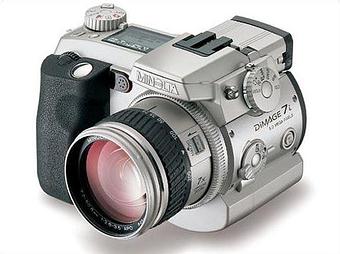 Like DiMAGE 7, DiMAGE 7i utilizes GT LENS with 7x optical zoom and 5-megapixel sensor. It differs from the predecessor by case design, improved autofocus algorithm (said to work twice as faster) with manual fine tuning capability, grid line or histogram generation on the viewfinder / LCD display, the least exposure time of 1/4000 c, the new Ultra High Speed (UHS) shooting mode - 7 fps at 1280x960 resolution), two additional macromodes and three video recording modes, wireless flash connectivity, saturation, contrast, and exposure control. Minolta DiMAGE 7i is expected for sale in the end of spring 2002. Canon presented a semi-professional EOS-D60 ($2500) camera. It features monoboard 6.3-megapixel CMOS matrix (3152 x 2068) with 2:3 ratio, the system of digital RGB filters, and 22.7 x 15.1 mm image size with 1.6x focal length scaling ratio. The product has an EF lens mount and provides a variety of professional capabilities. 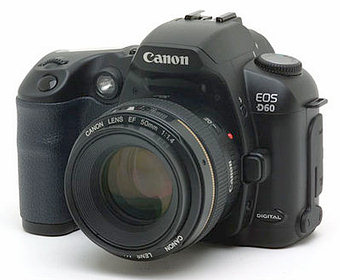 Canon EOS D60 is expected in European retail in the end of March 2002. Nikon's 6.1-megapixel D100 is similar, basing on a popular Nikon F80 mechanical camera, equipped with new generation speed logic. 6.31-megapixel (effective) CCD-matrix sized 23.7 x 15.6 mm with 1.5õ focal length scaling ratio and 12-bit analog-digital converter enables images at up to 3008 x 2000 resolution.  The camera has Nikon F (AF) removable optics. It's expected for sale in summer. Rollei presented 5-megapixel d530 flex ($2000) camera. It's interesting that it stores images in the RAW format only (10 bpp, 6.5 MBytes image file size), at that it features PCMCIA interface for connecting MicroDrive disks, CompactFlash or SmartMedia cards; it also has 2.5" (6.3 cm, 112,000 pixels) LCD display. 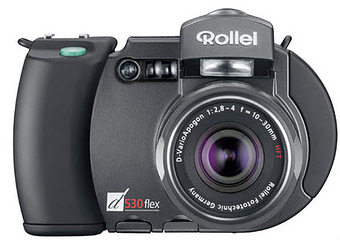 One of the camera's advantages is a good 5-megapixel CCD matrix and adaptive viewfinder optics, adjusting for user's eyesight in -3 to +2 dioptre range. Besides video-out, the camera features SCSI interface for direct PC link. Rollei d530 flex will appear for sale in the 2nd half-year of 2002. 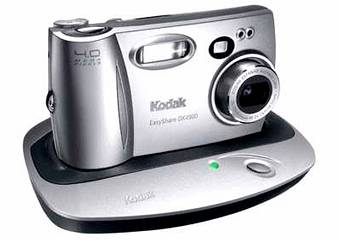 Kodak presented its first 4-megapixel camera (3.9 million effective pixels) - DX4900 (about $600) - designed in the same case as the last-year DX3900 novelty. With some exceptions, main features of Kodak DX4900 are identical to DX3900's, for example, it utilizes the same EasyShare system. The novelty is equipped with 2x optical and 3x digital zoom lens, Compact Flash Type I card slot, and feeds from two AA batteries. At CeBIT 2002 Minolta presented another interesting camera - DiMAGE F100 - featuring 1/1.8" 4.1-megapixel CCD sensor (4.0 million effective). 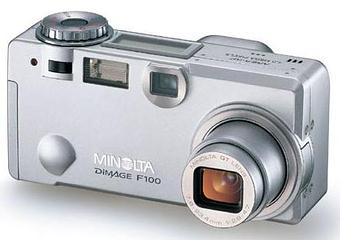 One of its main capabilities, differing it from other cams, is the special Subject Tracking autofocus feature. Besides, the camera has a number of programs for lighting analysis and optimal exposure mode selection. 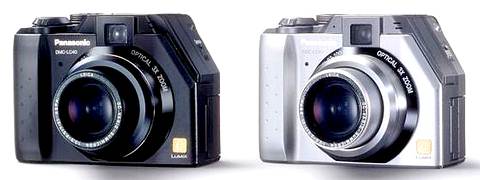 Among the large number of cameras, presented by Matsushita Electric together with Leica Camera A.G., I'll mark the LUMIX DMC-LC40 (about $530) with Leica DC VARIO-SUMMICRON lens and 1/1.76" 4.01 million CCD sensor (3.9 million effective), to be released for sale in April. The camera will be produced in two variants: silvery DMC-LC40-S and black DMC-LC40-K.  Leica presented Digilux 1 camera, also developed together with Panasonic. Leica Digilux 1 features 1/1.8" 4-megapixel CCD matrix and LEICA DC VARIO-SUMMICRON lens. Sony has just "heaped" it up with new models, presenting not only various design solutions and different matrices, but also cameras with alternative storage types: for example, 2-megapixel CD Mavica MVC-CD250 ($600) and 4-megapixel CD Mavica MVC-CD400 ($900), capable of storing images on 8 cm CD-R/RW discs.  MVC-CD250 features 3x digital and 2x optical zoom lens; it supports video recording with sound in MPEG HQX format and fast shooting. MVC-CD400 has 2x lens from Carl Zeiss, Hologram AF laser system for improved focusing in condition of underlighting. CD Mavica novelties are capable to compress and store shots to CD-R and CD-RW discs. 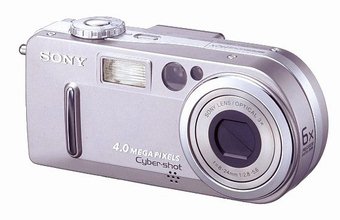 Another novelty from Sony. This time Cybershot series - a compact DSC-P9 ($570) to replace DSC-P5. The camera features 1/1.8" 4.1-megapixel Super HAD CCD matrix (4.0 million effective), 3x optical and 6x digital zoom lens and 14-bit DXP processor. Popular MemoryStick is used as the storage. 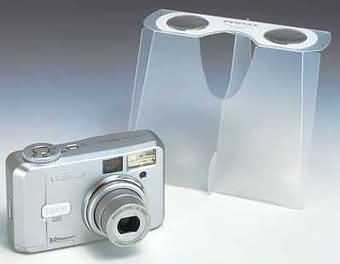 2-megapixel Pentax 230 camera was presented, featuring some stereophotography capabilities. In this mode one makes a shot, then changes the viewing angles and makes another one. The product is supplied with special stereoglasses. Another interesting exhibit of the month - new digital DZ-MV250 and DZ-MV270 video cameras from Hitachi with 8 cm DVD-RAM disc recording. 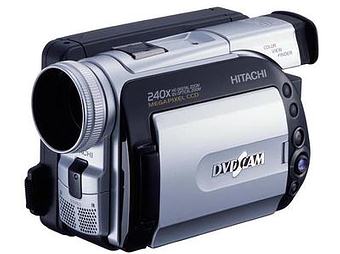 They feature 1.1-megapixel and 1/4" CCD matrices, capable of recording video (720,000 effective pixels) and shoot images (1.0 million pixels). Lens, covered with special antiglare coating, provide 12x optical and 240x digital zoom. Recording time is 60 minutes for an 8 cm DVD-RAM disc, or 120 minutes for double-side recording; it equals to 999/1998 1280 x 960 JPEG photos, respectively. Video format - UDF (Universal Disk Format) - meets DVD quality standard with MPEG-2 compression. MultimediaI can't say March was boiling with multimedia novelties. Of course, there were many of them both at CeBIT 2002, and out of it, still the last month hasn't brought us much innovations.
Still, there were some interesting events. Apogee Technology and STMicro announced the development of technologies for production of fully digital amplifiers to replace DAC chips in audio system tracks. 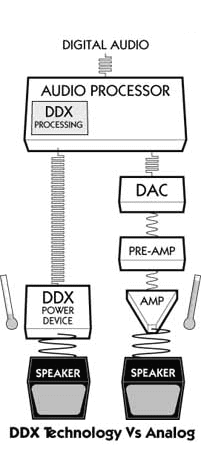 After Apogee got a license from ST Micro for DDX (Direct Digital Amplification) technology, the companies have already released 4.1-channel DDX controller and two DDX amplifier chips, providing up to 100 W output power. Further partnership results to be presented closely. Creative has only announced the 5.1-channel Cambridge DeskTop Theater PlayWorks 2500V Dolby Digital system ($150), equipped with all possible interfaces, including digital and optical; 24-bit decoder with Dolby Pro Logic support, integrated into the amplifier module; and Dolby Digital signal type auto recognition.  Analog stereo signal is played with use of Creative Multi-Speaker Surround (CMSS) technology, enabling to optimally separate two channels for 5.1-channel system. The central satellite has 21 W RMS power, back/front satellites - 7 W RMS, subwoofer - 20 W RMS.  HomeArena 5.1 acoustic system from German TerraTec was interesting as well. It consists of a subwoofer (8" speaker, 25 W RMS), central, two front and two back speakers (3" speakers, 6 W RMS) - 55 W RMS/1100 W P.M.P.O. total power. The system is supplied with a remote control. Among new sound cards I'll mark 5.1-channel DMX 6fire LT from the same TerraTec, being a light version of previously presented SoundSystem DMX 6fire 24/96.  DMX 6fire LT bases on EWX/EWS88 technology and is a fully-functional 24-bit/96 kHz solution. Remote MXR unit, situating in a spare backpanel slot, provides an optical digital input and output along with a Mic-In. The card features three analog 24-bit/96 kHz stereo outputs, analog 24-bit/96 kHz stereo input, digital 24-bit/96 kHz optical input and output, 24-bit/96 kHz Mic-In (3.5 mm plug). SNR doesn't exceed 104 dB/A; and together with software DVD players the product supports AC3 and DTS standards via digital outputs, Sensaura 3D; is compatible with A3D 1.0, Macro FX, and EAX 1.0/2.0; supports ASIO 2.0, GSIF (GigaStudio), and DirectSound (3D). 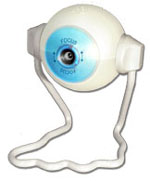 Among the numerous Web-cams, presented last month, I'd like to mark the first solution with USB 2.0 interface - iBot 2 ($99) from Orange Micro. The cam features a PCI controller with two USB 2.0 ports; it's equipped with 0.3-megapixel CMOS sensor with 60-degree viewing angle; and enables to send 640 x 480 picture at 30 fps without data compression, that is unreal for USB 1.1Web-cams. Besides, Orange Micro has also promised to release an IEEE1394 Web-cam with the same features as the iBot 2. Write a comment below. No registration needed!
|
Platform · Video · Multimedia · Mobile · Other || About us & Privacy policy · Twitter · Facebook Copyright © Byrds Research & Publishing, Ltd., 1997–2011. All rights reserved. |